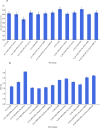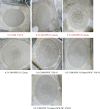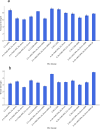Impact of propylene fibers and industrial wastewater on the properties of self-compacting concrete
- PMID: 40783418
- PMCID: PMC12335570
- DOI: 10.1038/s41598-025-13454-w
Impact of propylene fibers and industrial wastewater on the properties of self-compacting concrete
Abstract
Given the global water shortage crisis and the prevalent use of drinking water in concrete production, exploring practical solutions, such as reusing various wastewater, is essential. This study investigates the properties of self-compacting concrete (SCC) incorporating treated industrial wastewater sourced from dye factories. Propylene fibers at lengths of 6 mm and 12 mm were employed at volumes of 0.1% and 0.2%, with a water-to-cement ratio (w/c) of 0.5. Additionally, a 0.1% fiber concentration was tested in SCC with a w/c of 0.36, involving a 20% reduction in coarse aggregate in both scenarios except for control samples. While the use of treated industrial wastewater did not affect workability, propylene fibers reduced workability. When comparing samples using drinking water, the addition of 0.1% enhanced compressive strength by 10%, whereas a 0.2% propylene fiber concentration resulted in a 30% decrease in compressive strength. The inclusion of 1% propylene fibers with a length of 6 mm, combined with treated industrial wastewater, led to a reduction in compressive strength for low-cement mixes with a w/c of 0.5. Conversely, in high-cement mixes with a w/c of 0.36 using treated wastewater and 0.1% propylene fiber, the compressive strength increased compared to the control sample using treated industrial wastewater. Incorporating 2% silica fume as a cement replacement for both mixing designs resulted in a significant improvement in compressive strength at 90 days. Ultrasonic test results exhibited a strong correlation with compressive strength, highlighting the effectiveness of this method in evaluating mechanical properties. The volumetric water absorption increased with fiber incorporation, peaking at 66% higher than the control when using 0.2% fibers. However, the volumetric water absorption of the new sample mixture with 6 mm propylene fibers, 440 kg/m3 cement, treated industrial wastewater, and silica fume is under 5%. These findings underscore the potential of both propylene fibers and silica fume to enhance concrete strength and reduce volumetric water absorption when using treated industrial wastewater, indicating progress in sustainable concrete technologies. SEM images reveal that SCC samples made with treated industrial wastewater exhibit more voids, cracks, and Ettringite, potentially compromising their compressive strength. Nevertheless, the addition of silica fume improves the integration and homogeneity of the cement paste. Significantly, the presence of C-S-H is more prominent in these samples, with a lower Ca/Si ratio correlating with increased compressive strength.
Keywords: Fracture toughness; Mechanical properties; Polypropylene fibers; Self-compacting concrete; Treated industrial wastewater.
© 2025. The Author(s).
Conflict of interest statement
Declarations. Competing interests: The authors declare no competing interests.
Figures
















References
-
- Ghosh, S. & Ghosh, S. Water crisis in urban and sub-urban areas: A global perspective. Saudi J. Bus. Manag. Stud.6(8), 327–344 (2021).
-
- Fattah, K. P., Al-Tamimi, A. K., Hamweyah, W. & Iqbal, F. Evaluation of sustainable concrete produced with desalinated reject brine. Int. J. Sustain. Built Environ.6(2), 183–190. 10.1016/j.ijsbe.2017.02.004 (2017).
-
- Gorjian, S. & Ghobadian, B. Solar desalination: A sustainable solution to water crisis in Iran. Renew. Sustain. Energy Rev.48, 571–584 (2015).
-
- Asadollahfardi, G., Delnavaz, M., Rashnoiee, V. & Ghonabadi, N. Use of treated domestic wastewater before chlorination to produce and cure concrete. Constr. Build. Mater.105, 253–261. 10.1016/j.conbuildmat.2015.12.039 (2016).
-
- Asadollahfardi, G., Asadi, M., Jafari, H., Moradi, A. & Asadollahfardi, R. Experimental and statistical studies of using wash water from ready-mix concrete trucks and a batching plant in the production of fresh concrete. Constr. Build. Mater.98, 305–314. 10.1016/j.conbuildmat.2015.08.053 (2015).
LinkOut - more resources
Full Text Sources
Research Materials

